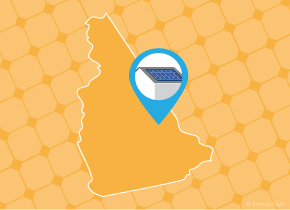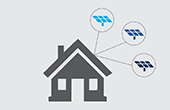History of solar policy in New Hampshire
Overall, the Granite State’s solar policies demonstrate a commitment to making solar more accessible over the past few decades. In addition to promoting solar for environmental concerns, decreasing solar costs and high state electricity prices have helped increased demand over the past few years. As of today, New Hampshire has developed about 85 megawatts (MW) of solar energy capacity ranking it 38th on SEIA’s national ranking of 2018.
The first enacted solar policy in New Hampshire dates back to 1976 when policymakers passed a Property Tax Exemption for Renewable Energy as a local option for cities and towns. Today, more than 100 cities and towns have used this policy to relieve homeowners of this property tax to make solar more accessible. In 1986, the state followed the tax exemption with Solar Easements to ensure provisions for homeowners that they have the right to unobstructed access to solar energy.
Following these early solar policy wins, New Hampshire adopted one of its most influential policies more than a decade later by approving a net metering program in 1998. Throughout the U.S., net metering has been crucial for the solar energy industry by allowing residents to store surplus net energy in the electric grid and receive compensation for it on their energy bill. Based on New Hampshire’s recent amendments in 2018, utilities must reward solar billing credits to homeowners with energy installations under 5 MW, which effectively includes all residential systems. Because state policymakers have fought to continue strengthening their net metering program, even more residents will be able to take advantage of this significant financial incentive.
Beyond net metering, the most important policy that New Hampshire has passed to help solar is the Renewable Portfolio Standard (RPS) that began in 2007. Like net metering, state energy requirements have been imperative to the development of clean energy across the nation. For New Hampshire, state electricity providers, excluding municipals utilities, are mandated to supply 25.2 percent of their retail electricity sales from renewable energy sources by 2025. The legislation also includes a carve-out provision for solar that requires 0.7 percent of this energy to be supplied by 2020.
For utilities, these goals must be met or they face fines known as alternative compliance payments. New Hampshire has actually put these fines to good use by using them to fund the Residential Small Renewable Energy Rebate program, which offered $0.20 per watt up to $1,000 or half the cost of the system for any system 10 kilowatts (kW) or less beginning in 2008. The Public Utilities Commission (PUC) put this incentive on hold in 2017 due to surging demand that could not be met.
While New Hampshire has already realized a wide variety of policies to incentivize going solar, the state has not stopped supporting the industry. The latest solar policy initiative from New Hampshire was approving virtual net metering in 2013. The program makes going solar for residents the easiest it has ever been by allowing residents to receive net metering credits for surplus generation by subscribing to off-site solar installations. Although the program got off to a slow start, the success of this system in other states should provide an optimistic projection for further usage in the near future.












